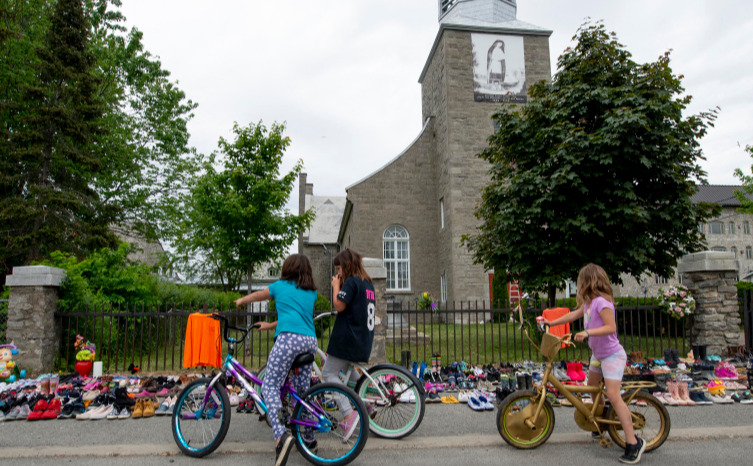
Children in the community of Kahnawake, south of Montreal, Quebec, stop to view the hundreds of children's shoes placed in front of the St Francis Xavier Church to commemorate the remains found at a residential school in British Columbia [Peter McCabe/AFP]
Montreal, June 2 (RHC)-- “They would just start beating you and lose control and hurl you against the wall, throw you on the floor, kick you, punch you. That is how Geraldine Bob, a survivor of the Kamloops Indian Residential School, described her experience at the facility in the Canadian province of British Columbia (BC), where the remains of 215 Indigenous children were recently found in an unmarked grave.
Bob’s testimony was shared by the Truth and Reconciliation Commission of Canada (TRC), which in 2015 determined that Canada had committed “cultural genocide” by forcing more than 150,000 Indigenous children to attend residential schools across the country between the 1870s and 1990s.
The system intended to assimilate Indigenous children into Canadian society and eliminate what state officials at the time described as an “Indian problem”; children were forcibly separated from their parents and siblings, beaten for speaking their Indigenous languages, and suffered rampant malnutrition, physical violence, forced labour and sexual abuse.
The discovery of the children’s remains in Canada’s westernmost province on Thursday has reopened persistent wounds for First Nations, Métis and Inuit, especially residential school survivors and their families. But Indigenous advocates said it is only the tip of the iceberg – and across the country, longstanding calls for government action are growing louder.
Indigenous families “had said for years and years that they knew that there were unmarked graves, that they knew that there were all of these children missing”, said Pamela Palmater, a professor and chair of Indigenous governance at Ryerson University in Toronto.
“This one unmarked grave, of the many that are out there, is exactly what genocide looks like in this country,” Palmater told Al Jazeera. “And until we get to the truth, until we bring all of these children home, until we stop engaging in the actions that lead to the deaths of Indigenous peoples, the genocide continues.”
Canada formally apologised for its residential school system in 2008, and as part of a class-action settlement with survivors, more than $2.68 billion ($3.23 billion Canadian) in compensation has been paid to more than 26,700 claimants, according to a report issued earlier this year.
Canadian Prime Minister Justin Trudeau, who campaigned on a promise to relaunch Ottawa’s relationship with Indigenous people, said on Friday that the mass grave found at Kamloops residential school was “a painful reminder of that dark and shameful chapter of our country’s history”.
Trudeau on Sunday ordered flags lowered to half-staff on federal buildings in honour of the 215 children found, as well as “all Indigenous children who never made it home, the survivors, and their families”. A day later, he also said excavating burial sites is an important step in the path to healing and pledged to support survivors and their communities going forward.
But Eva Jewell, an associate fellow at the Yellowhead Institute, a First Nations-led research centre, said Canada has implemented only eight of 94 Calls to Action issued by the TRC five years ago – including several related to the more than 4,000 Indigenous children believed to have died at residential schools. “Many, if not most, [of those children] are likely to be buried in unmarked and untended graves,” the commission reported.
The recommendations included calls for Canada to fund a national deaths register, to work with churches, Indigenous communities and residential school survivors to map cemeteries at the schools, to respond to families’ wishes for commemorations and markers, and to implement a strategy to identify, monitor and protect cemeteries.
“Last year, in 2020, no Calls to Action were completed. If the trend continues … we won’t actually complete these Calls to Action for another 50 years,” Jewell told Al Jazeera. “The pace of truth and reconciliation is incredibly slow, which is insulting given that many survivors are now ageing and passing away, and that we have continued and ongoing issues in our communities that are a direct result of these schools – that ensure that new generations to come are continuing to suffer.”

